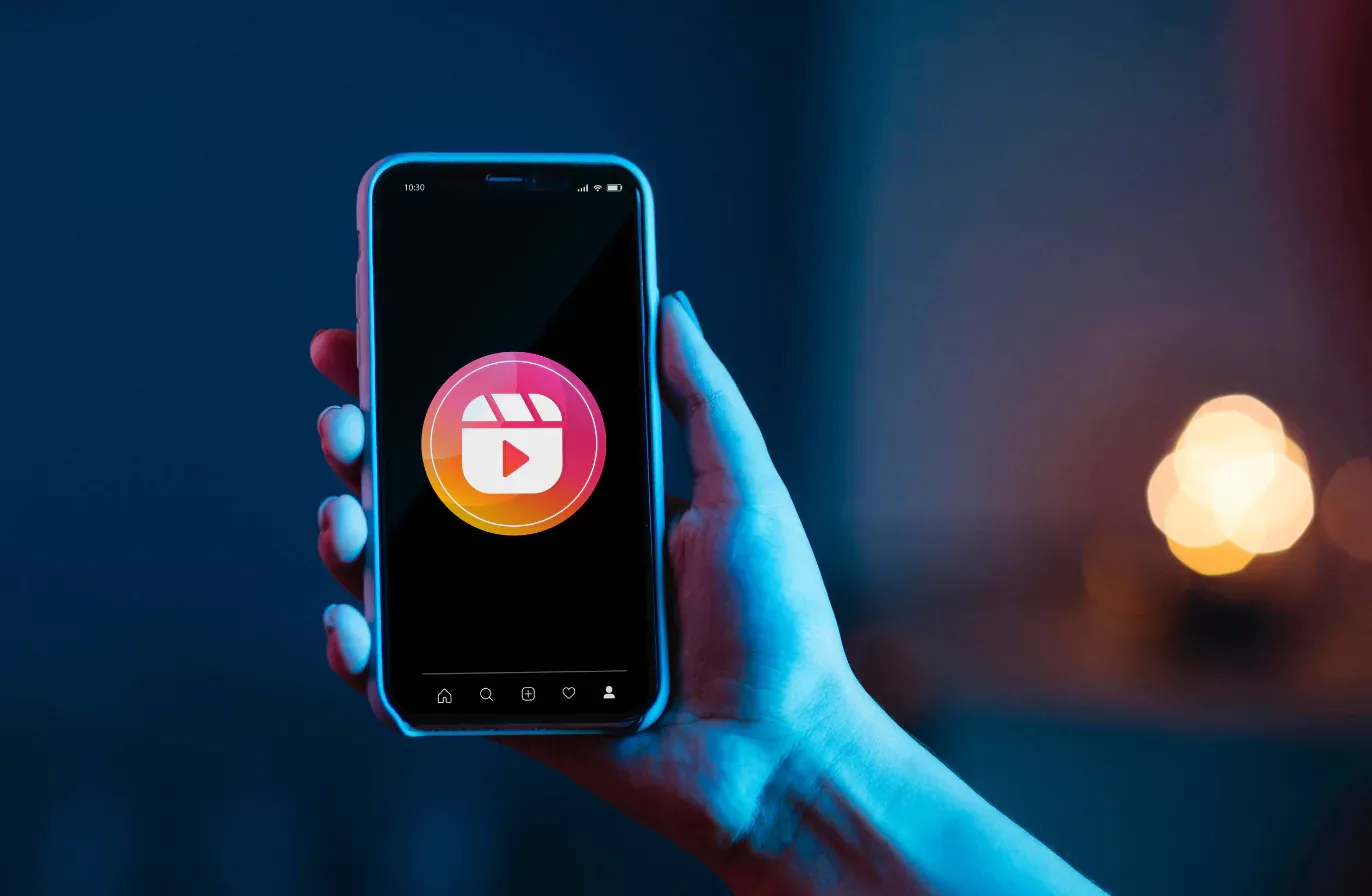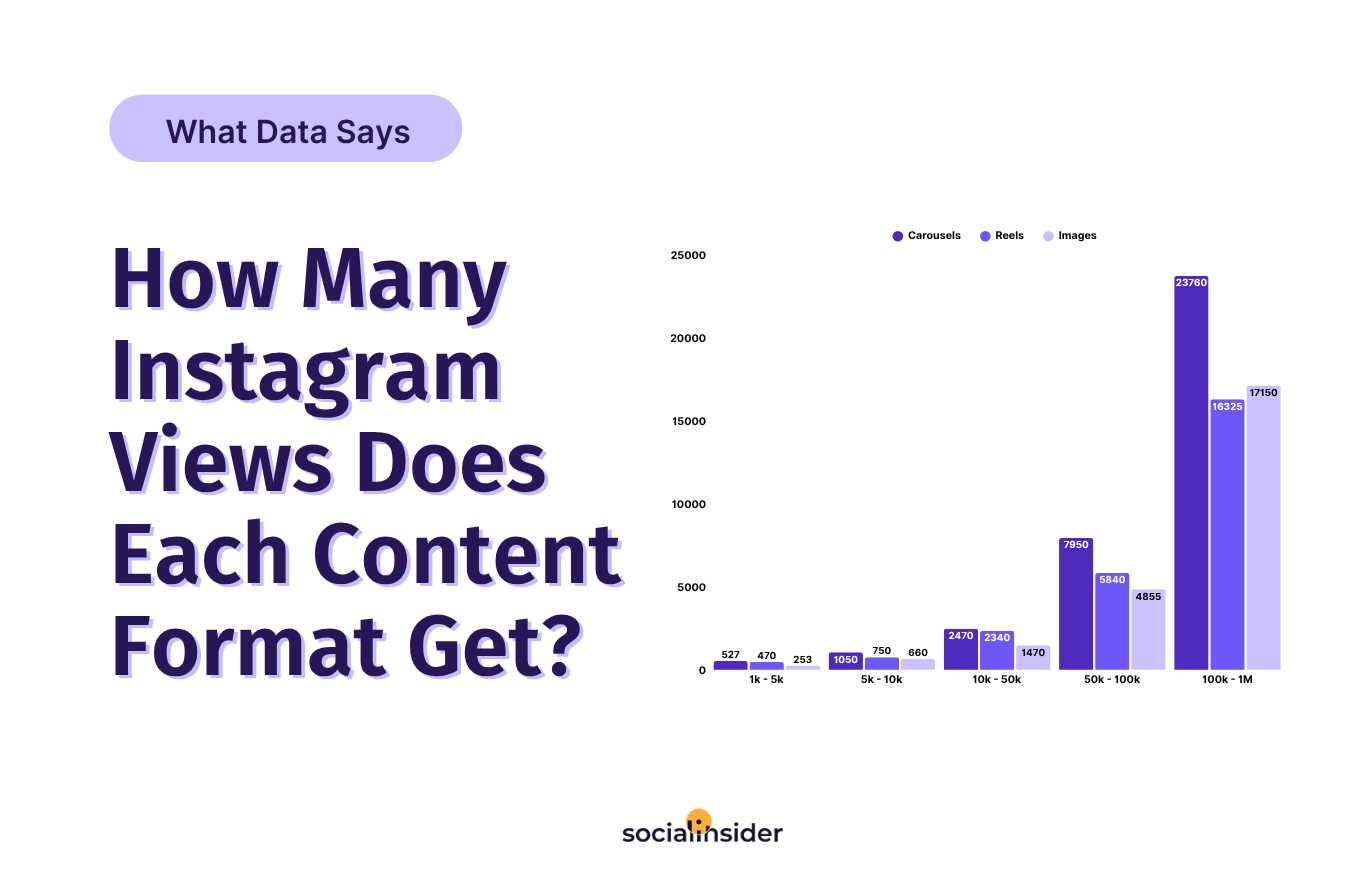18 Valuable Instagram Metrics for Marketers
Instagram metrics help you evaluate your social media performance and get optimization insights. Discover what important data you should track!

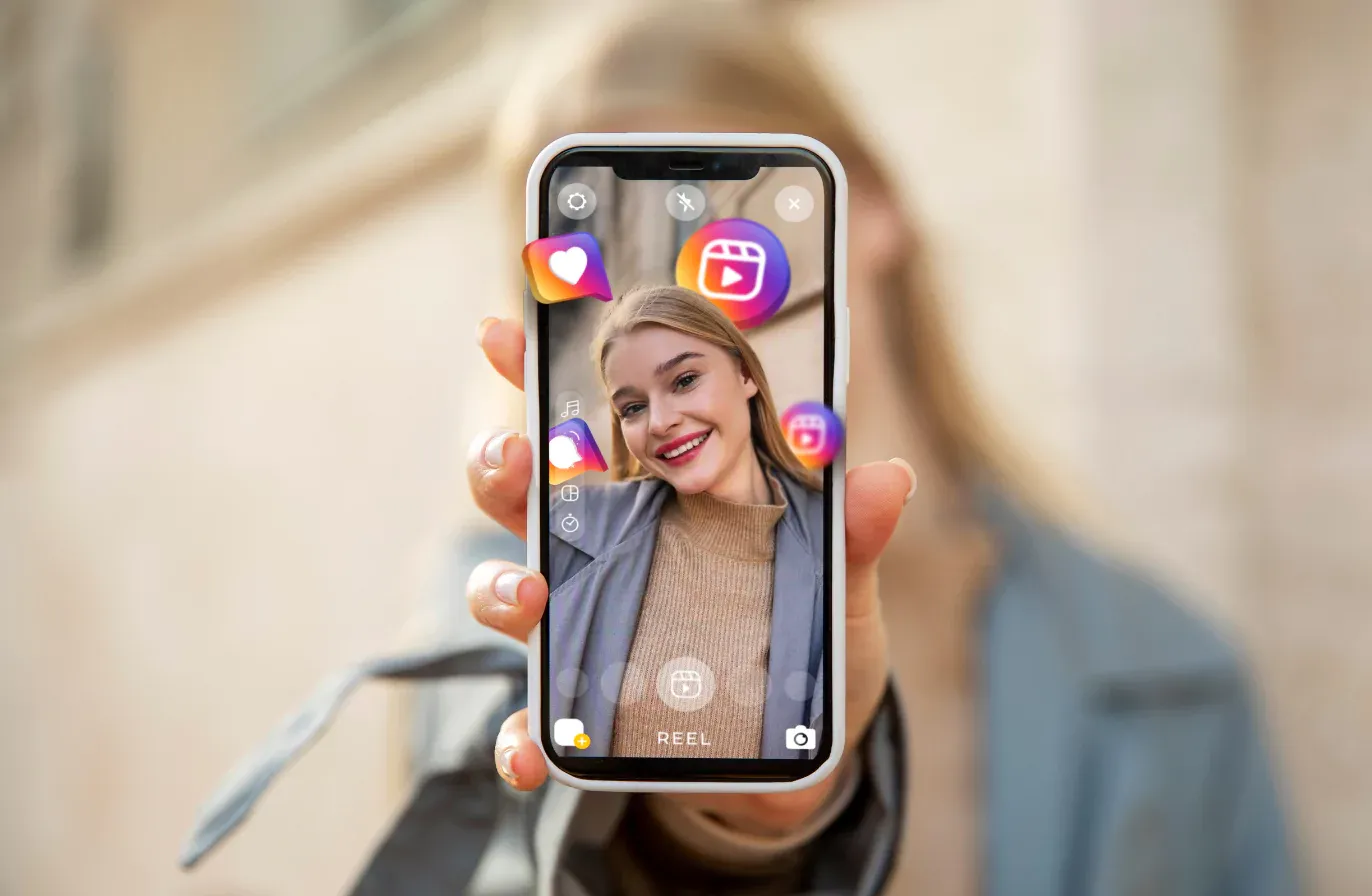
Instagram is well known as a leading platform for visual content and dynamic storytelling. For businesses and influencers, understanding Instagram metrics is essential for maximizing the platform's potential to achieve growth and success.
Instagram analytics provide valuable insights into user engagement, content performance, and audience demographics, helping to shape an effective Instagram marketing plan.
This article explores the key aspects of social media analytics and metrics and how they fit into a broader strategy.
Let's dive in!
Key takeaways
What are Instagram metrics, and why track them?
Instagram metrics represent key performance indicators (KPIs) that marketers use to evaluate their content strategy's effectiveness in achieving the goals established for their brand's Instagram marketing efforts.
When trying to increase brand awareness on Instagram, you need to keep tabs on how your content is performing, which means regularly checking your Instagram KPIs.
While tracking your Instagram data can help you in a variety of ways, we'll just briefly name the most important benefits of a performance analysis down below.
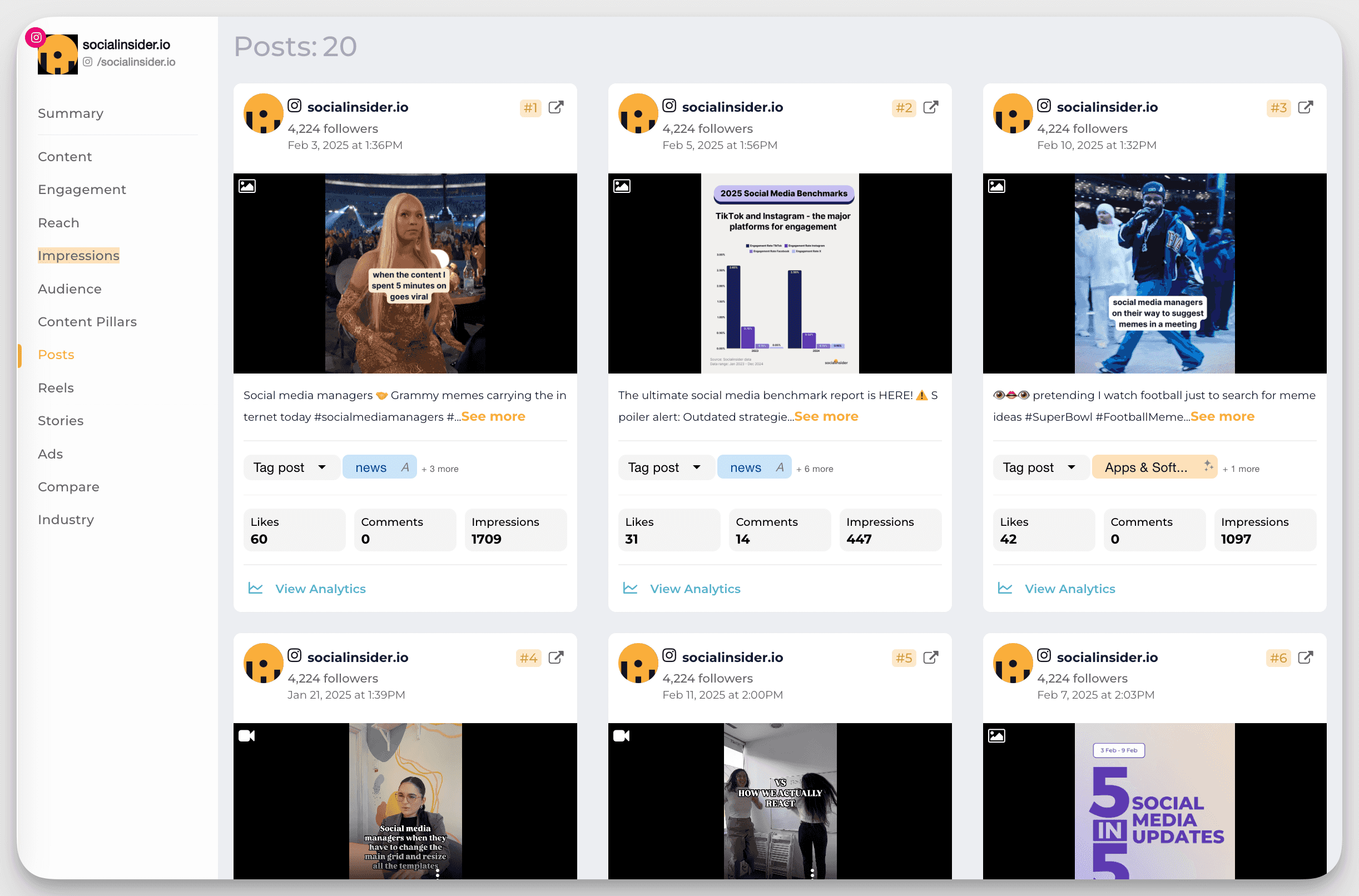
Understand how your Instagram performs
Unlock the power of your Instagram strategy with Socialinsider. Analyze, track, and transform your strategy into something extraordinary!
Start a 14-Day free trialEvaluate your Instagram performance
With the help of an Instagram analytics tool, you can identify if and how your audience responds to your brand's messages. If your followers are interacting with your posts, it means they find value in the content you're sharing—which is the goal.
By overseeing your metrics, you can also understand what their habits are when interacting with your brand. For example, do they share your posts? More than they comment? Do they watch your videos? What percentage of them?
Get a better understanding of your audience
Instagram audience data is imperative to track in order to discover if your social media strategy is effective in attracting your target audience.
Once you understand what followers you attract the most in terms of gender, age, and location, you'll be able to evaluate your current content approach and—if necessary—change it.
Adjust your content strategy
When you look at important Instagram metrics, such as your top posts, to see how they’ve performed, you figure out what type of content attracts most of your audience.
This will help you strengthen your social media content strategy, focusing on certain aspects that have already been proven effective. You’ll be able to create engaging content based on what you know works best for your brand and increase brand awareness, leads, and—ultimately—sales.
Identify trends
By keeping an eye on your metrics on Instagram, you learn more about the latest content trends and optimize your strategy on the go.
Adapting to what's trending will keep your followers engaged, boost your brand awareness, and grow your sales.
18 Essential Instagram metrics to track
The metrics you track will be heavily dependent on what your overall goals are for your Instagram performance.
Do you want to engage your audience? Or do you care more about conversions and the end result?
Add these 18 Instagram metrics to your monthly reporting so you can accurately measure your overall performance.
#1. Views
Views on Instagram are the number of times your content was seen. This refers to any type of content, including reels, posts, stories, videos, live videos, and even your ads.
This is a newer metric specific to Instagram. While you’ll often see specific metrics like video views, Instagram is now showing total views that all of your content receives.
Why it's useful:
Knowing how many times your content is viewed helps you get an idea of the amount of people you’re reaching with your posts.
Instagram also provides additional details, like the percentage of followers versus non-followers that are viewing your content. Having this information is important because it lets you know if you’re reaching more people who aren’t following you or vice versa.
If you’re getting more views from followers, you may want to test different types of content to appeal to a wider audience. If you’re getting more views from non-followers, you may want to add a call-to-action to follow you or look for ways to get those non-followers as part of your permanent audience.
How to track views:
Views is a newer metric that’s only available through the native app. Go to your profile in the Instagram app, tap the hamburger menu, then tap Insights.
You’ll find Views right at the top of your Insights Overview.
You can then click through to see even more data on your Instagram views. Instagram will also display the percentage of followers versus non-followers who have viewed your content
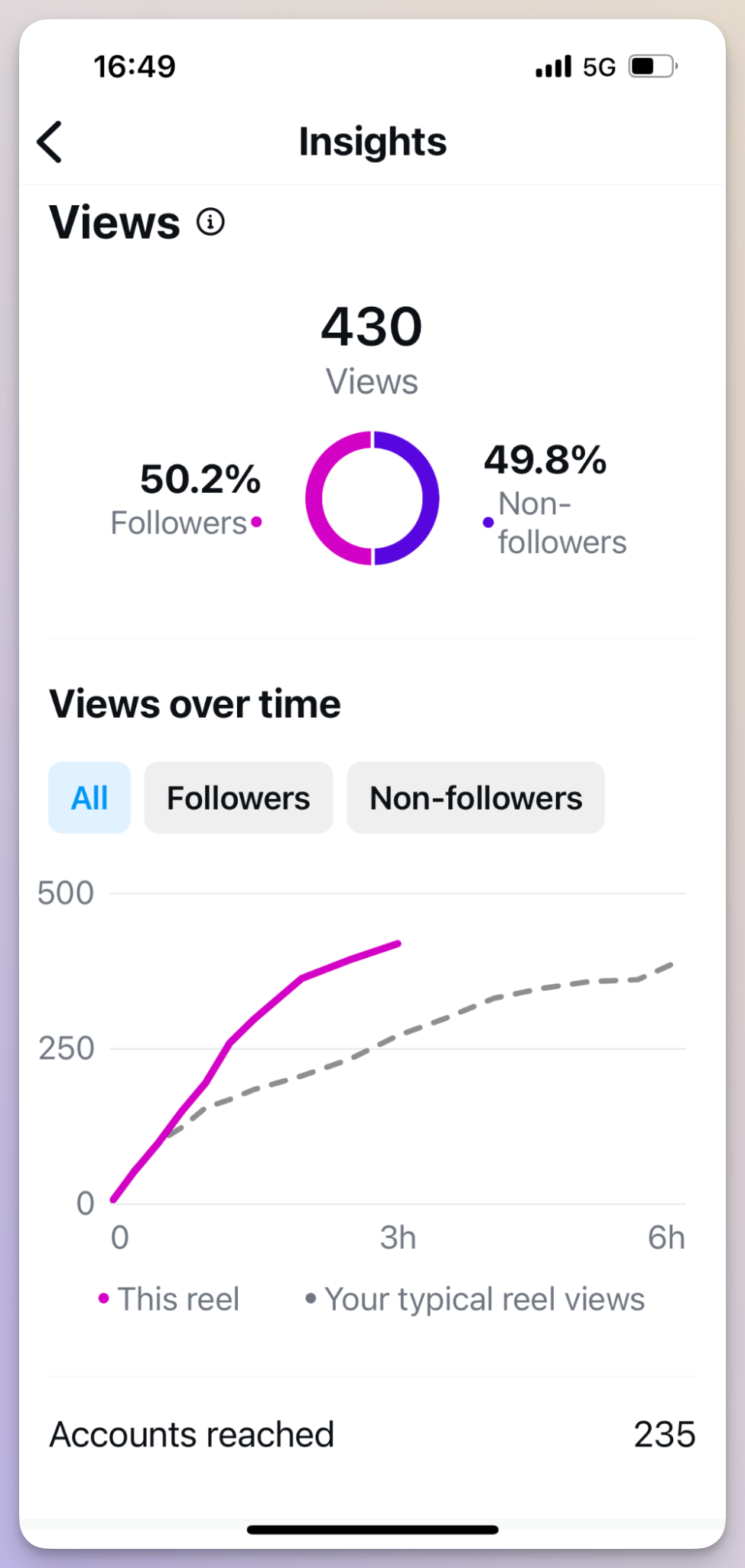
Other data you can find in your Views section includes:
- Accounts reached: The number of people your content reached
- Audience data: Your top countries, cities, gender distribution, and age ranges
- Profile visits: The number of times people visited your Instagram profile
- External link taps: The number of taps on your Instagram profile link(s)
#2. Reach and average reach
Reach refers to the number of people your content reaches. This is different from views, as that calculates the number of times your content was seen in total, regardless of who saw it. Reach refers to the specific number of accounts reached by your content.
Average reach gives you an average number of accounts reached during a given time period, like the last week, month, or quarter.
According to Instagram, the platform and its algorithm looks at reach in two different ways: connected reach versus unconnected reach.
Connected reach refers to accounts you’ve reached that already follow you and unconnected reach refers to accounts you’ve reached who do not yet follow you.
Why it's useful:
Reach lets you know how many different people are seeing your content. And if you look in the native Instagram app, you can see the percentage of followers (connected reach) versus non-followers (unconnected reach).
Compare the number of followers you’ve reached to your total follower count to get an idea of how many followers tend to see your content.
How to track reach:
You can see Accounts reached in the Views dashboard of your Instagram app’s built-in analytics.
Or, you can use a third-party tool like Socialinsider to access both your total post reach and your average reach. And if you’re running ads, you’ll be able to gauge how much reach you get total versus just from your organic posts.
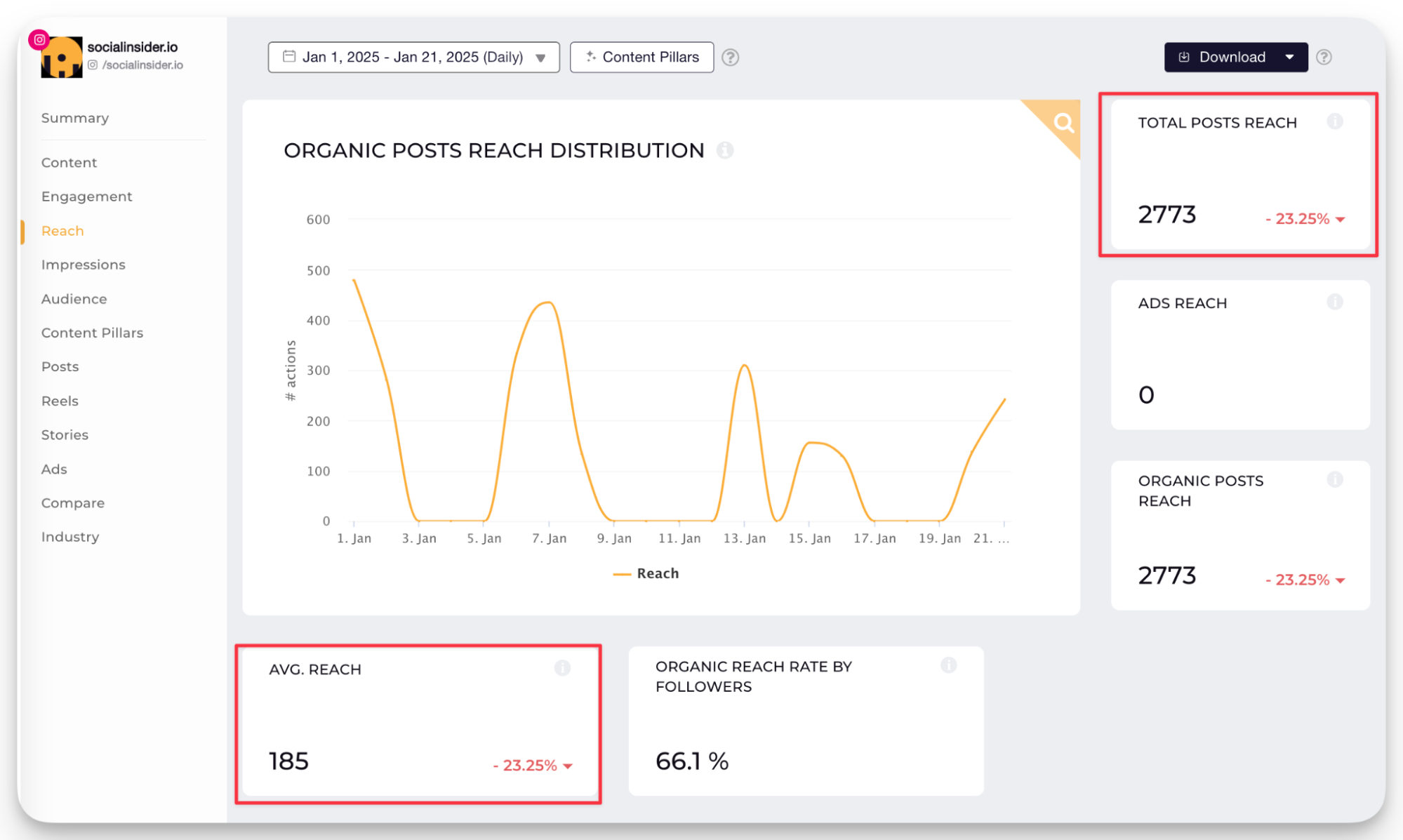
To find this data, log into your Socialinsider account and make sure your Instagram profile is connected. Then, click on that Instagram account from the left sidebar to access all of the analytics available to you.
Click the Reach link to view reach-specific details.
#3. Likes
Your likes refer to the total number of likes (hearts, double taps, etc.) that your content has received. This is just one type of interaction that you’ll see on Instagram
Why it's useful:
Likes are the easiest form of engagement on the Instagram platform, so they’re the most common one you’ll see. But they’re also an indication of whether or not someone—for lack of a better word—liked your content.
The more likes you get, the better the indicator that you’re doing something right with your content strategy.
How to track likes:
You can track your likes within your Instagram insights. Head back to the menu in your app, tap Insights.
From here, you have two options.
You can tap Interactions to view all interactions with your content within a certain time frame. Or you can go down to the Content You Shared section and look at your likes on each post.
You can also track likes inside Socialinsider. Head to the Engagement tab of your Instagram analytics and scroll down to see your total likes as well as average number of likes per post.

#4. Likes per reach
Likes per reach is a metric that looks at how many likes a post received compared to how many people saw said post. This is an important metric to the Instagram algorithm, so it’s one you want to pay attention to.
Why it's useful:
Likes are important for connected reach. If you want to reach more of your followers, you need to pay attention to your likes—and for added context, your likes per reach.
Looking at how many people liked your post out of the total number of people it reached gives you an idea of its effectiveness and how well it resonates with your audience. You want a high likes per reach ratio.
How to calculate it:
To calculate your likes per reach, simply divide the total number of likes your post received by the total number of people it reached. You can find these numbers in your Instagram insights by looking at the post-by-post details.
In addition, we will soon be adding this metric into the Socialinsider dashboard, given that Instagram itself has stated its importance.
#5. Shares per reach
Similar to likes per reach, shares per reach tells you how many shares a post received compared to how many people it reached. Another important algorithm metric, this shows you how many people are sending your content to others.
Why it’s useful:
Shares in general are a powerful metric. This means people liked your content enough to want to send it to someone else so they could enjoy it, too. Powerful.
This metric is also useful for boosting your unconnected reach. The more shares your posts get, the more likely your content is to be recommended to others that don’t yet follow you.
How to calculate it:
Calculate your shares per reach by dividing the total number of shares a post has by its reach. Again, find these in your post data in Instagram.
This metric is also soon to be added into the Socialinsider dashboard, so keep an eye out so you don’t have to do the math yourself.
#6. Average watch time per reel
Average watch time refers to the average time spent watching your Instagram reels. Average watch time per reel, then, refers to the average time spent watching each individual reel you share.
Why it’s useful:
This metric is the primary driver of Instagram reach, indicating how likely a user is to watch the entire video. So you want to have a clear picture of how long people spend watching your videos so that you know if they’re enjoying your content or if they’re scrolling through.
For example, if your average watch time per reel is a lot less than the length of your reel, most people aren’t watching all the way through. This gives you a good indicator that your content isn’t as engaging as it should be.
How to track average watch time per Reel:
You can track this metric right inside your Socialinsider dashboard.
You have two options here: track your average watch time per reel from the Posts section or see your total average watch time in the Reels section.
To see the average watch time per reel, head to Posts, then click View Analytics on the reel you want to monitor.
You’ll see this interface below, giving you all sorts of great KPIs surrounding each reel:
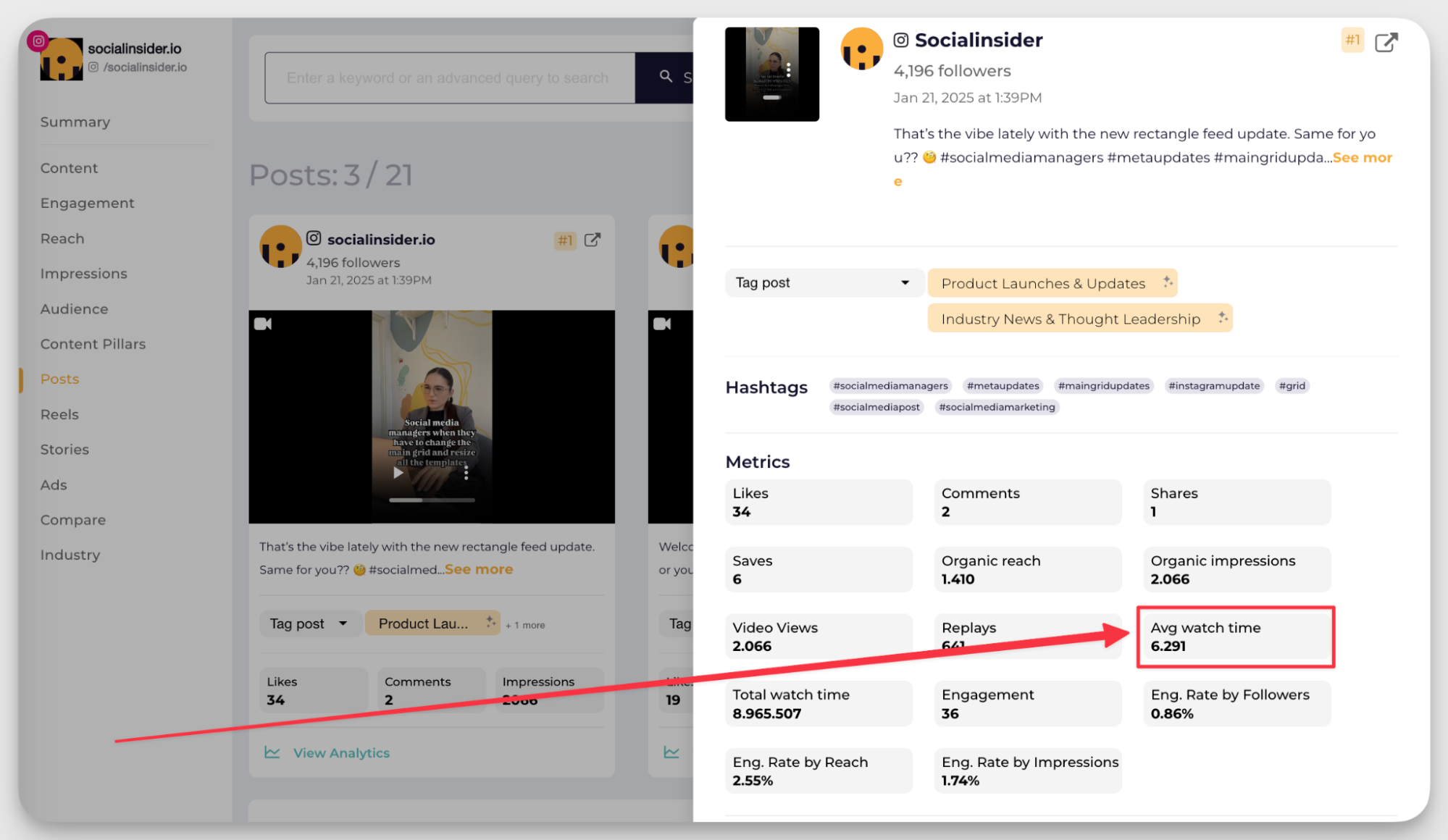
#7. Impressions and average impressions
Impressions tell you how many times your content was seen. This probably sounds familiar, doesn’t it? That’s because your impressions are the same as your views.
However, views is an Instagram insights-specific metric, and impressions (as well as your average impressions) can be found using a social media analytics tool.
Why it’s useful:
Just like with views, you want to have a good idea of how many times your content is being seen. You can compare your reach and your impressions to see how many times individual people are seeing your content, as well.
Reach is the number of people who have seen your content, while impressions are the number of times your content has been viewed.
So if one of your posts had 100 reach and 150 impressions, you can estimate that people viewed your content an average of 1.5 times.
However, you can also just look at total impressions and average impressions to see how often your content is being viewed.
How to track impressions:
You were able to see your views right inside your Instagram app, which is useful for a quick peek at your performance. However, when doing a deeper dive, you’ll want to use a tool like Socialinsider.
Click on your Instagram page from your Socialinsider sidebar, then click the Impressions section to see data on how often your content is being seen. You can find both Total Posts Impressions and Average Impressions here.
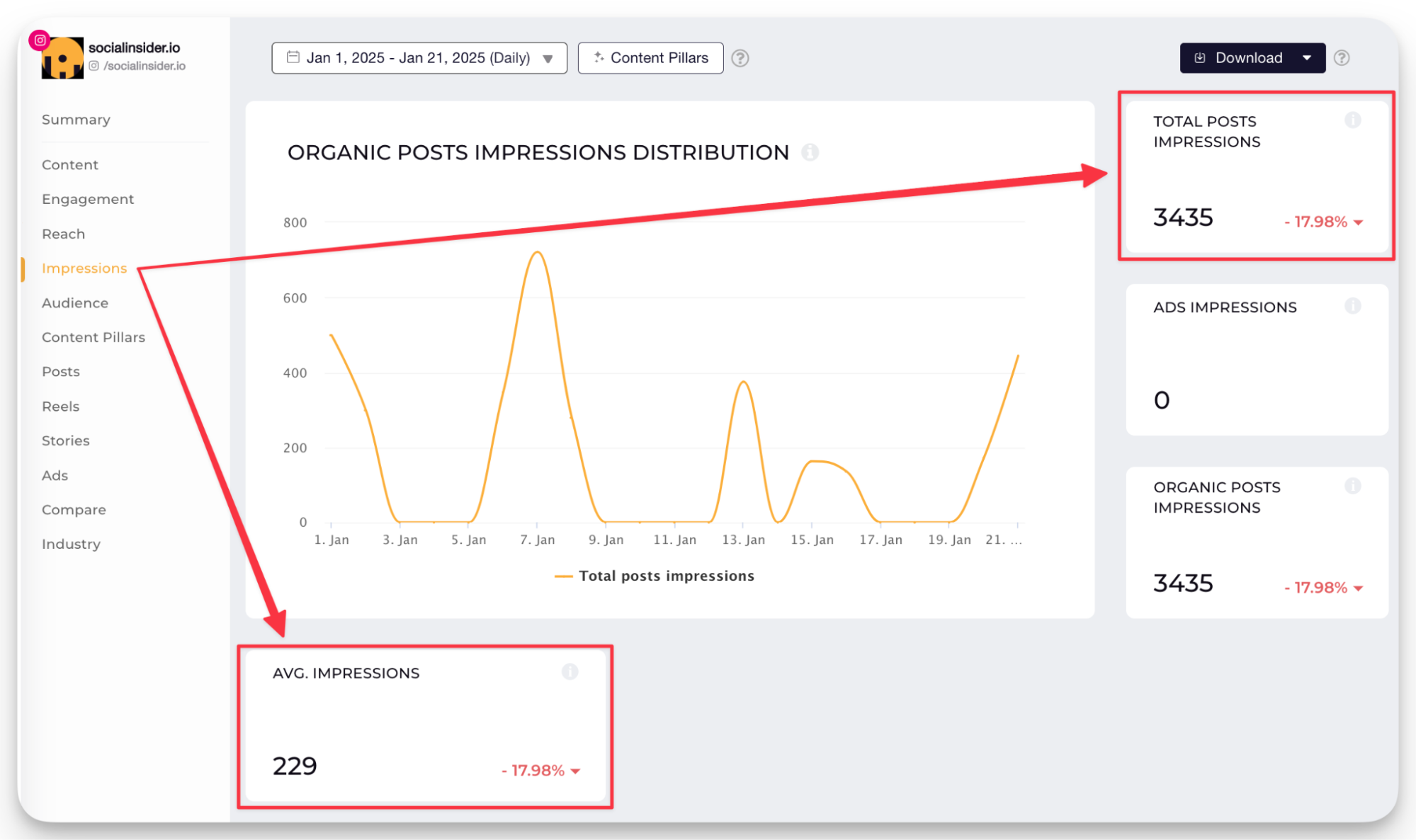
Plus, you can see a distinction between ad and organic impressions if you’re currently running any Instagram ads.
#8. Follower growth
Your follower growth refers to how much your follower count is growing—whether that’s a positive (follower count growth) or a negative (follower count loss) number.
Why it’s useful:
Follower growth has long been referred to as a vanity metric, as the number of followers you have doesn’t always mean anything if those followers aren’t actually seeing and engaging with your content or Instagram profile.
However, if you’re looking to grow your online presence and brand awareness, follower growth is often still a good metric to look to.
How to track follower growth:
You can see your follower growth in your Instagram app by heading back to your insights overview, then tapping the Total followers metric.
Here, you’ll be greeted by data like:
- Growth
- Top locations
- Age range
- Times your followers are most active
However, you can also track your follower growth within a third-party tool like Socialinsider.
Head to your Instagram profile’s analytics dashboard, then click Audience to access follower-specific metrics.
You’ll see a line graph indicating your follower count over time, as well as numbers showcasing your Follower Growth and Total Followers for the time period you’ve selected.
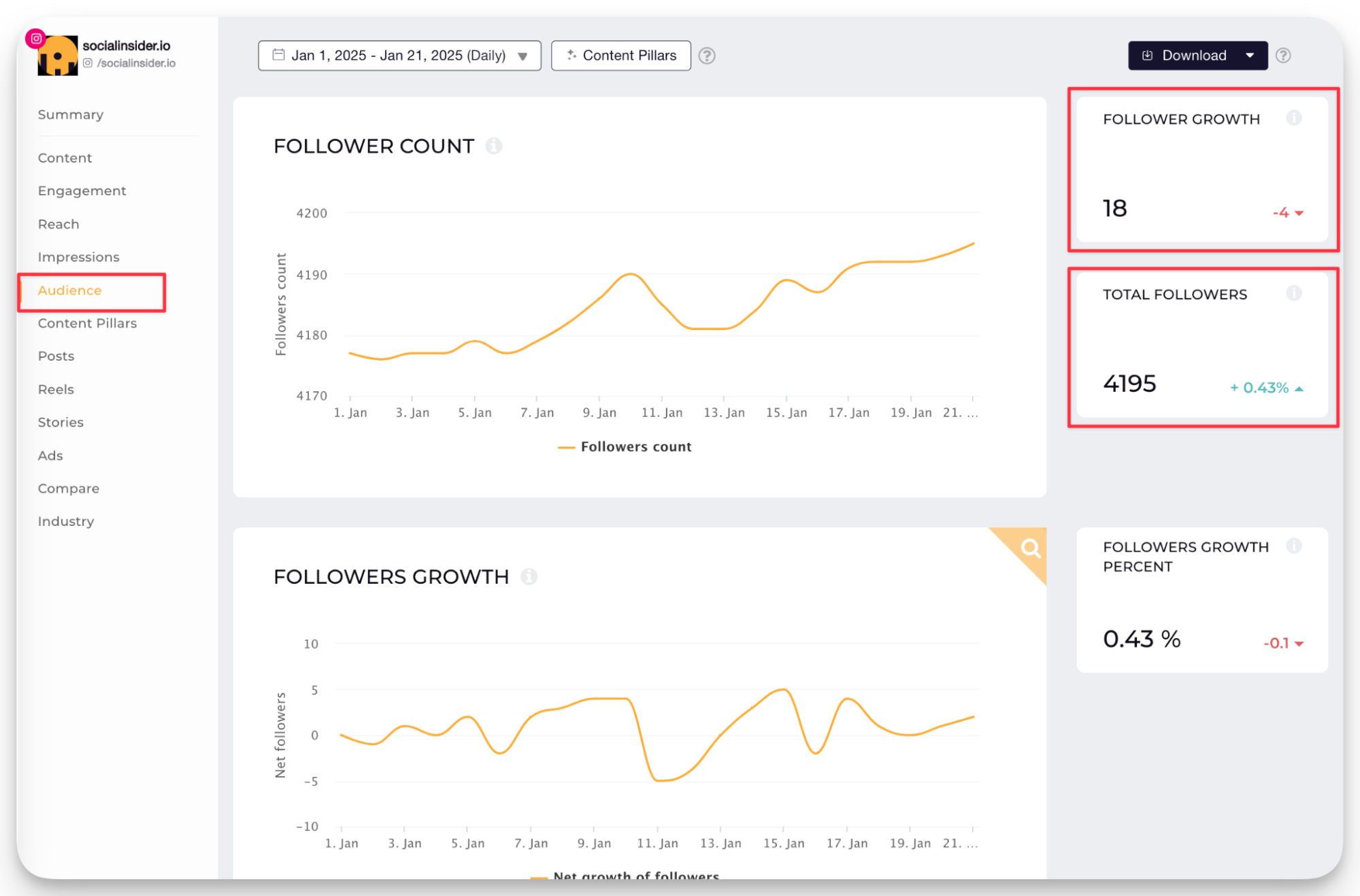
#9. Engagement and engagement rate
Engagement is an all-encompassing metric for any type of interaction with your content, whether it’s a like, comment, share, profile click, what have you.
Your engagement rate is a metric you can calculate by comparing your engagement to your post reach, telling you how many of the people who either saw your content or follow your page have interacted with your posts.
Why it’s useful:
One of the most important indicators of performance is engagement. It’s nothing if people follow your account and see your content if it doesn’t make them also want to interact with it.
So you need to have a number of interactions your content is getting, as well as an idea of how many of your followers or the people who’ve seen your content are interacting with it.
How to track engagement and engagement rate:
Head to your Socialinsider dashboard, click on your Instagram account, then click over to the Engagement tab to find details on your account’s engagement metrics.
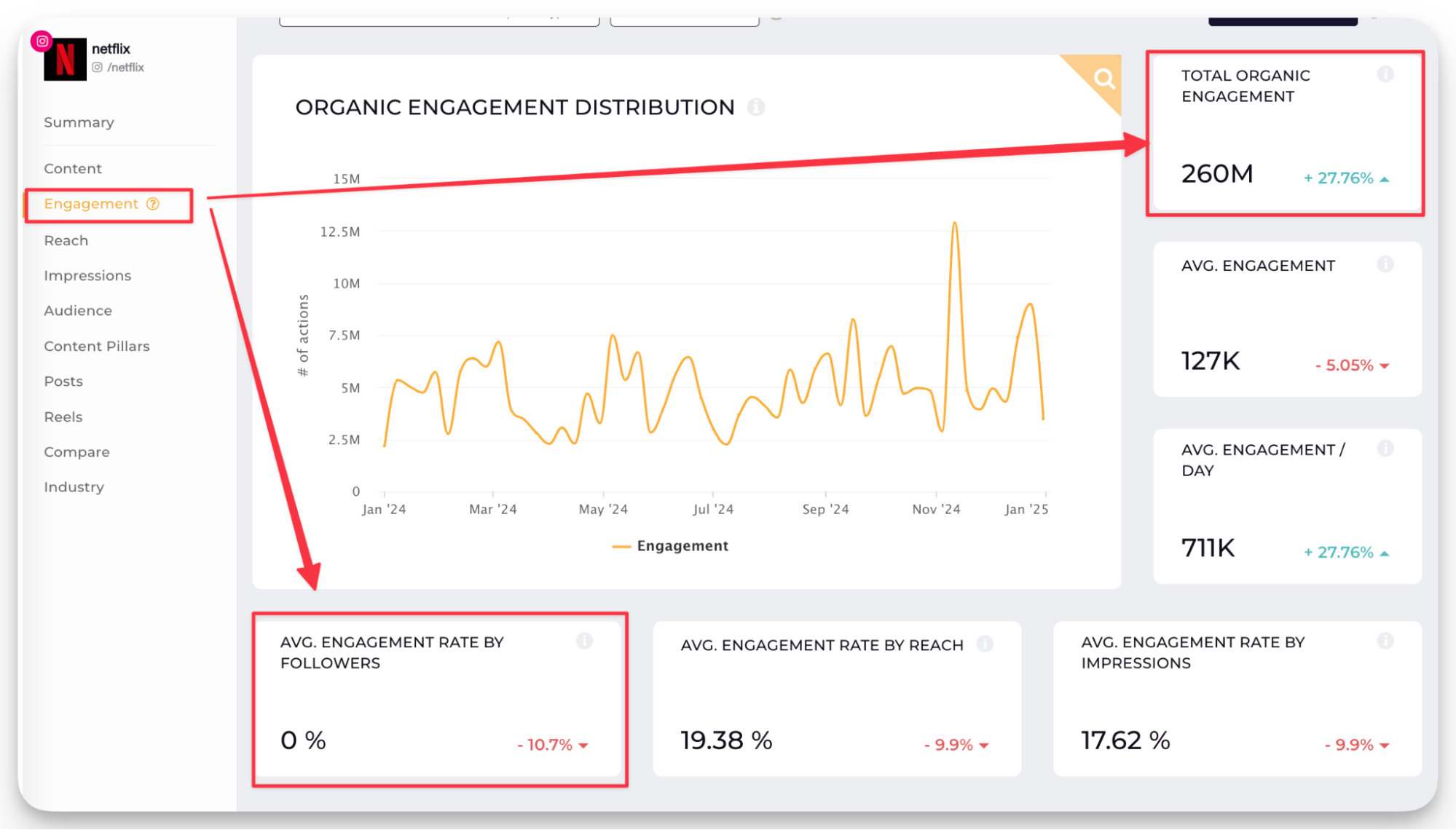
You’ll see your total engagement for the time period that you set, as well as three different engagement rate metrics:
- Engagement rate by followers: This divides your total number of engagements by your follower count, letting you know how many of the people who follow you have also engaged with your content.
- Engagement rate by reach: This divides your total number of engagements by your post reach, letting you know how many of the people who saw your content also engaged with it.
- Engagement rate by impressions: This divides your total number of engagements by your total impressions, letting you know how many of the times your content was shown to people resulted in them engaging with it.
You can also use an Instagram engagement rate calculator to make this easier on you.
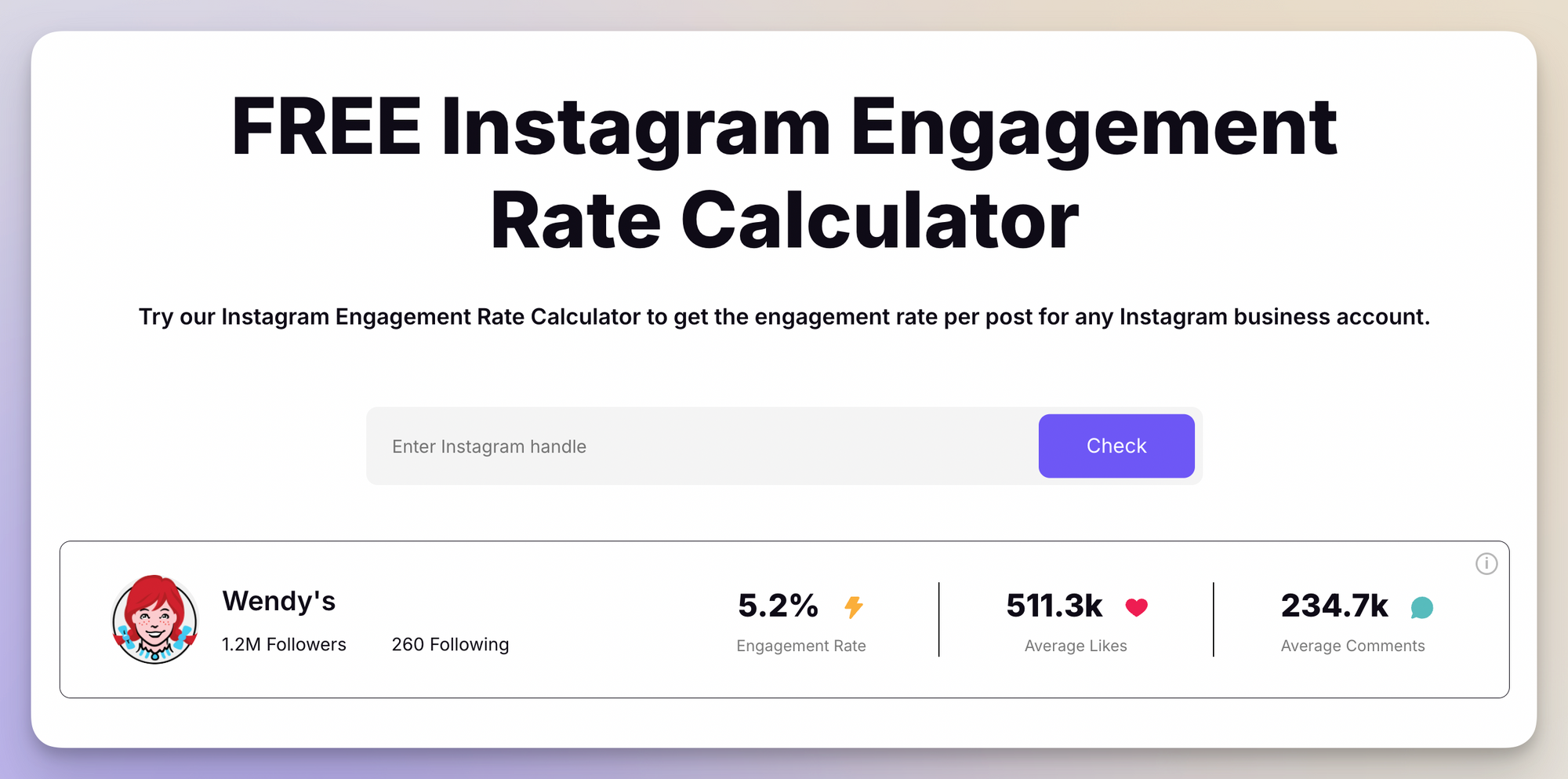
#10. Engagement benchmarks
Benchmarks are points of reference or comparison for your own performance. For example, your engagement benchmarks refer to how well your engagement stands up against your competitors’ and your industry’s engagement.
Why it’s useful:
You can look at your own total engagement count and engagement rate and decide if you’re happy with those numbers, but it’s difficult to tell if your metrics are good or not without knowing how others in your industry are performing.
Looking at industry benchmarks gives you a goal or a comparison marker for your own engagement.
How to track engagement rate:
First, you can easily find Instagram benchmarks to compare your engagement rate to average engagement on the platform as a whole.
For example:
- The average engagement rate for Instagram carousels is 0.55%
- The average engagement rate for Instagram reels is 0.50%
- The average engagement rate for single image posts is 0.45%
Or, you can use Socialinsider to look at how your engagement compares to your competitors’ actual performance.
First, make sure you’ve added Instagram profiles for your closest competitors to your Socialinsider dashboard.
Click Benchmarks in the right sidebar, then click Instagram.
You’ll be able to select or deselect profiles you want to compare as well as which metrics.
Make sure Engagement is one you’ve selected (though there are additional related metrics you can measure as well), then view the table that compares your engagement to your competitors.
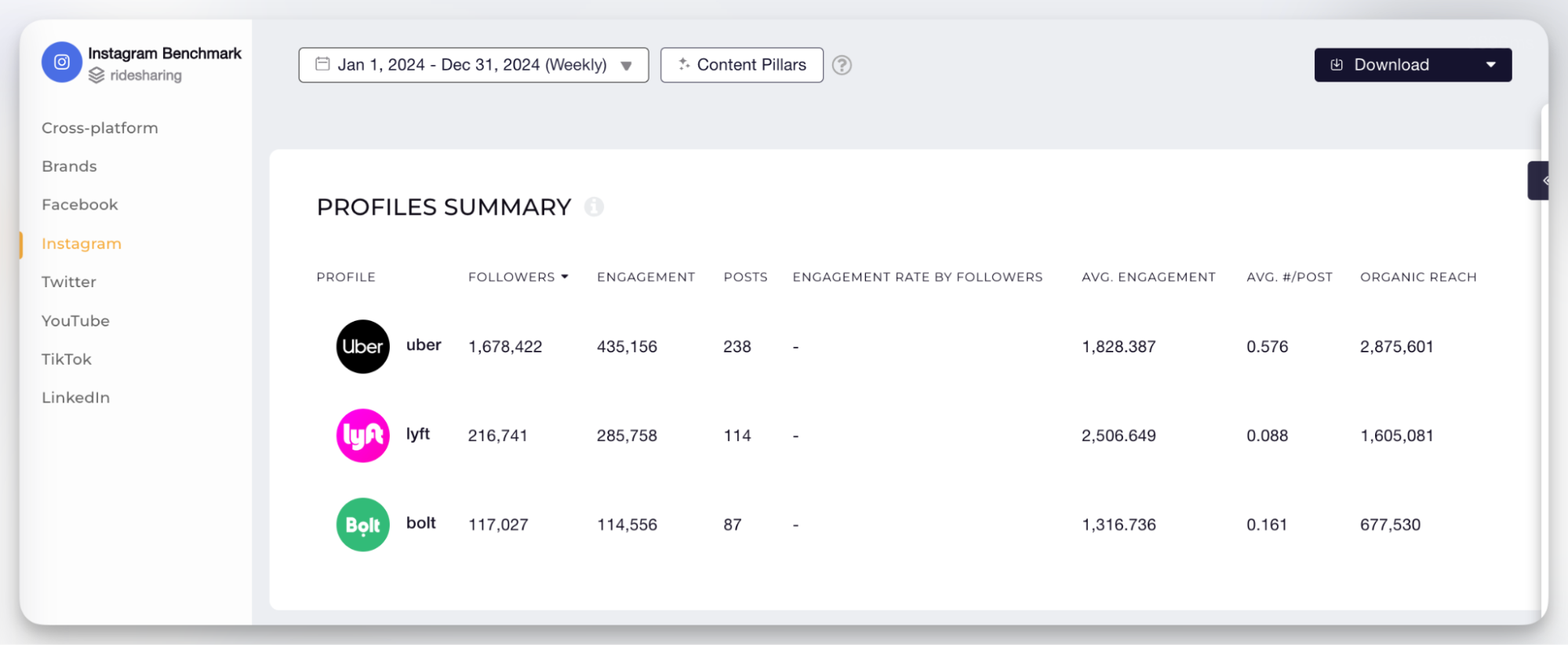
#11. Top posts
Your top posts Instagram metric refers to your posts that are performing the best. There are different ways to measure this—you might be looking for posts with the most likes, or posts with the most engagement.
Why it’s useful:
Looking at your top posts helps you understand what types of content your audience likes. This, in turn, helps you to create more of it.
How to track top posts:
You can see your top posts in your Instagram app by going to your insights and tapping See all by the Content You Shared header. From there, you can sort your posts by views, accounts engaged, accounts reached, or shares, depending on what dictates a “top post” in your book.
You can also see your top posts in Socialinsider by clicking on your Instagram profile and then going to the Posts tab in the right sidebar.
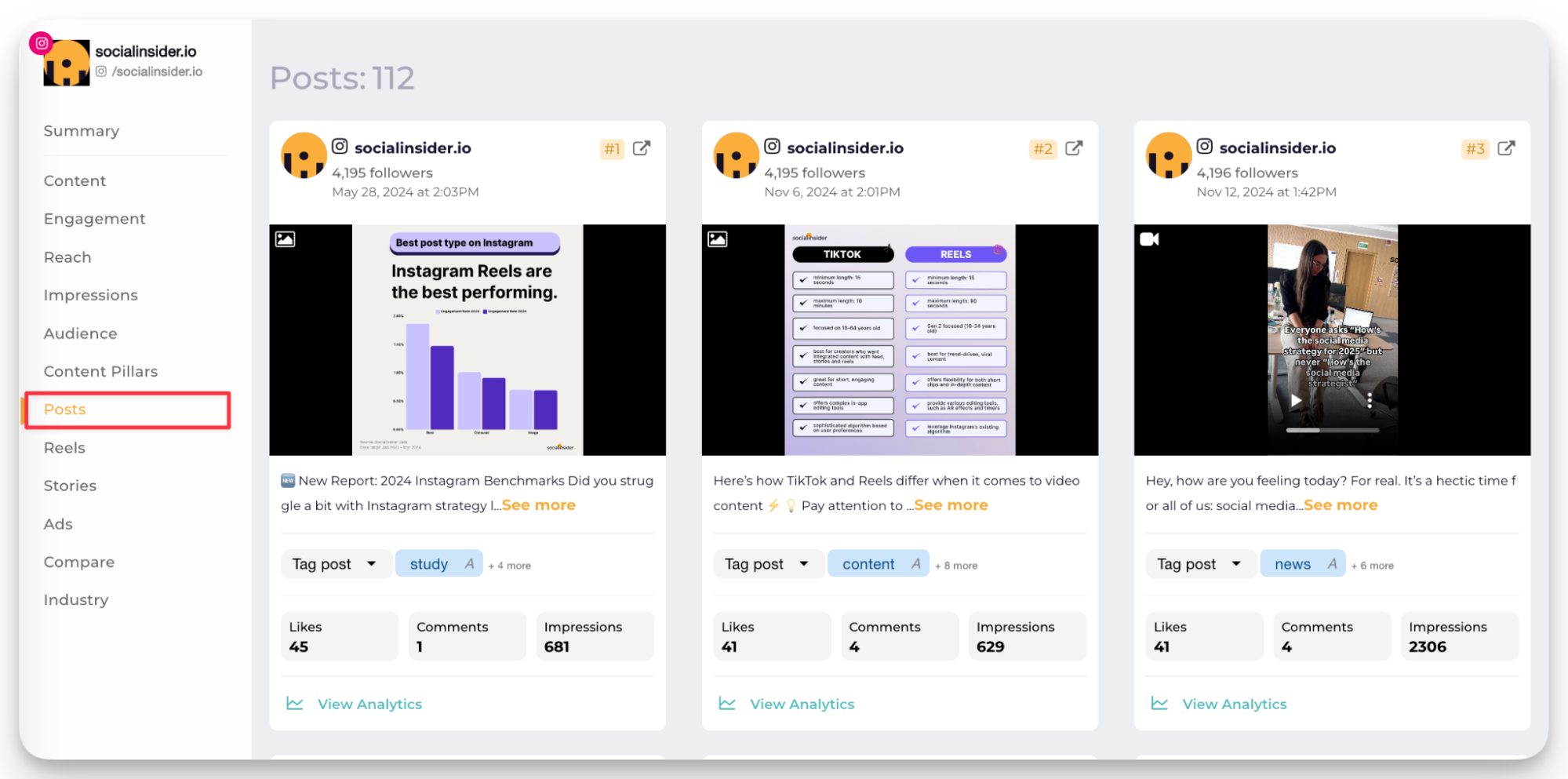
At the top, you’ll be able to sort by the metric that means the most to you from:
- Engagement
- Engagement rate
- Date posted
- Comments
- Likes
#12. Saves
Saves are a unique feature on Instagram that allows users to bookmark a post and save it into a folder or collection that’s accessible from a user’s menu.
Why it’s useful:
If someone has saved your content, it means it interests them enough that they want to be able to find it and come back to it later. This is a powerful indicator of how well your content is doing, so Instagram has made it possible to view how many times your posts have been saved.
How to track saves:
Track your saves by heading to the Engagement tab in your Socialinsider dashboard. Scroll down until you reach the section that gives you data on your saves.
Here, you can see the total number of saves your content received in the time period you’ve set, as well as the average number of saves each of your posts gets.
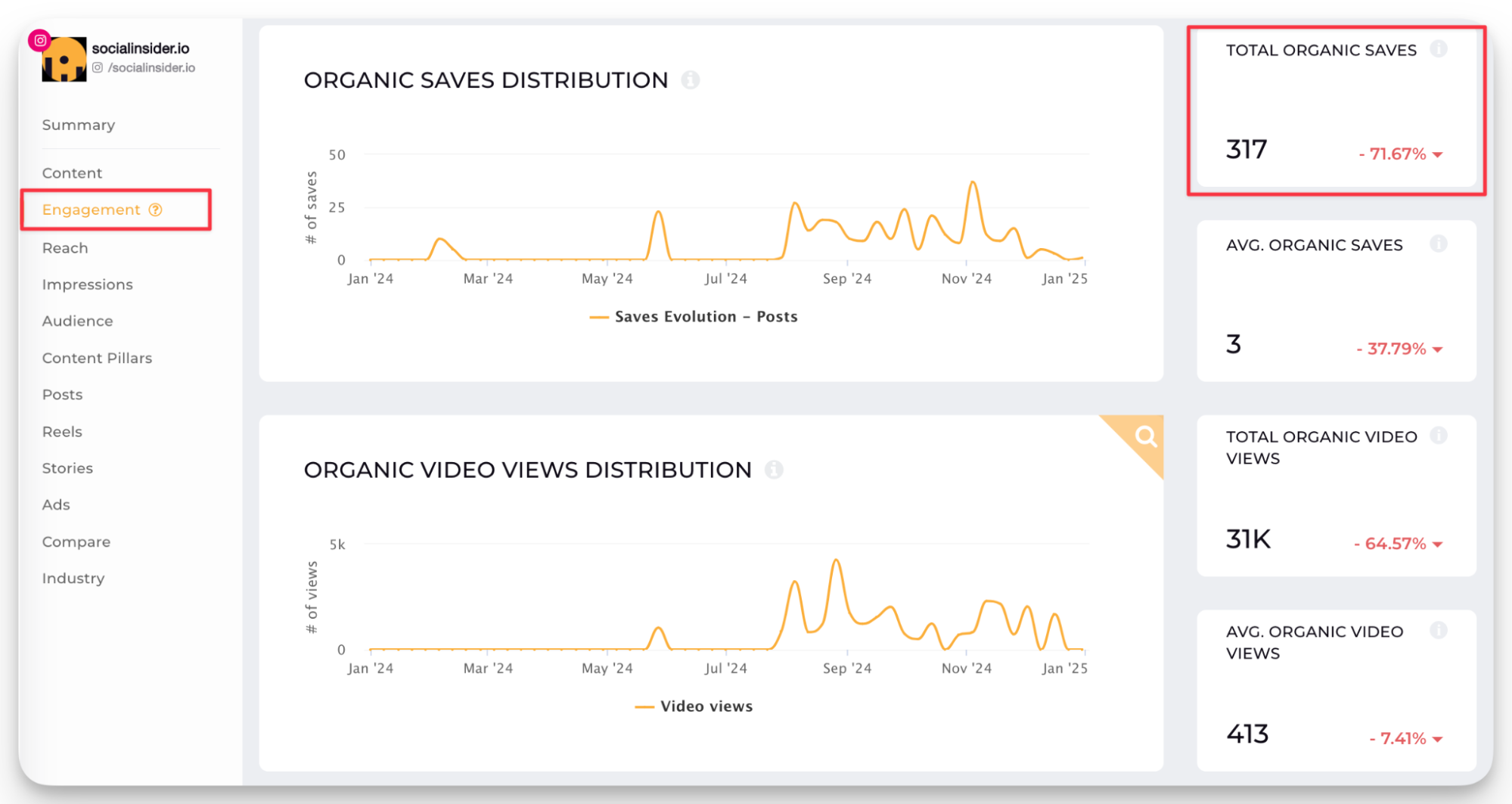
#13. Comments
Comments as a metric obviously refers to the number of comments left on your Instagram posts.
Why it’s useful:
Someone is only going to leave a comment if they have something to say. Seeing a lot of comments comes in means your content resonated so well with your audience, it made them want to talk to your brand about it.
How to track comments:
You can track your comments using Socialinsider. Click on the Engagement tab of your Instagram analytics and scroll down to see your total comments as well as average number of comments per post.

#14. Traffic from Instagram: Story clicks, post clicks, link in bio
Traffic refers to clicks to your website directly from Instagram. These can come from your bio link(s), story clicks, or ad clicks.
Why it’s useful:
Marketing may have a lot of goals, but ultimately, every brand’s main objective is to get conversions, making traffic an Instagram metric that should not be overlooked.
How to track traffic from Instagram:
There are a couple of ways you can track your website traffic from Instagram. First, you can use a link-in-bio landing page that tracks each time someone clicks on a link.
Second, you can use UTM parameters that add a tracking code to the end of your link. Use your Google Analytics account to set these up, then monitor your Instagram traffic from there.
#15. Leads from Instagram
Leads refer to potential customers who are likely to turn into an actual customer. This may be someone who came from Instagram to your website and filled out a form, checked out your products, or read a blog post.
Why it’s useful:
It’s important to know when you’re reaching potential customers so that you can continue to market to and nurture them.
How to track leads:
Being able to track leads is another important reason to set up UTM parameters. They help you track your social media ROI, like when leads or conversions come from a specific platform.
#16. Reels metrics: views, shares
If Instagram reels are a big part of your strategy, you’ll want to pay close attention to Reel-specific metrics like views and shares.
Why it’s useful:
Knowing how your reels are performing helps you to create more engaging Instagram reels to further boost your performance.
How to track Reels metrics:
You get an entirely reels-specific analytics dashboard inside Socialinsider. Click on your Instagram profile, then click the Reels tab so you can see data like:
- How many reels you’ve posted
- Reels engagement
- Engagement rate
- Likes
- Comments
- Impressions
- Reach
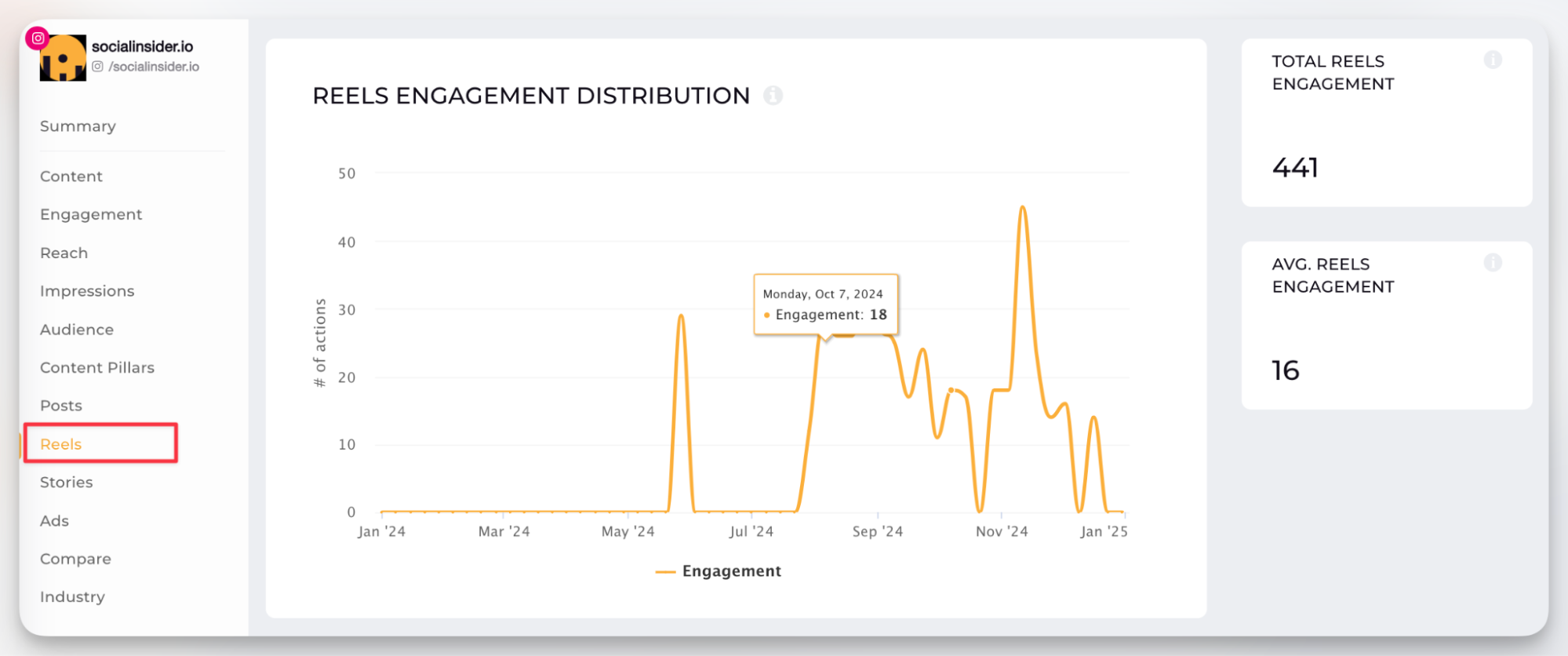
#17. Instagram Stories metrics
If you post Instagram stories regularly, you’ll also want to keep tabs on their performance: how many views they got, interactions, clicks, and the like.
Why it’s useful:
Instagram stories are a fun feature that can help you further engage your audience. Keeping an eye on how well they resonate with your followers can help you improve your stories strategy.
How to track stories metrics:
Similar to your Instagram reels, you’ve got an entire dashboard for stories data right inside Socialinsider.
Click your Instagram profile, then click Stories to access data like:
- Number of stories posted
- How many stories you posted each day (on average)
- Impressions
- Replies
- Retention rate (or the number of people who watched your full sequence of stories)
- Best time to post
- Reach
- Stats by story type
- Top stories

#18. Profile interactions
You have a few buttons and other links on your profile that your audience can interact with. Things like messaging you, checking out your shop, clicking your bio link(s). You can track these interactions to see how many people are interested in learning more about your business.
Why it’s useful:
Knowing how many people are interacting with your profile buttons or links tells you that there are people who want to know more about what your business does. Pay attention to which interactions they do so you know if you need to adjust your profile buttons.
How to track profile interactions:
You can only track profile interactions in the native Instagram app. Head to your Instagram insights overview, then tap Interactions to view your profile interactions amongst your other metrics.
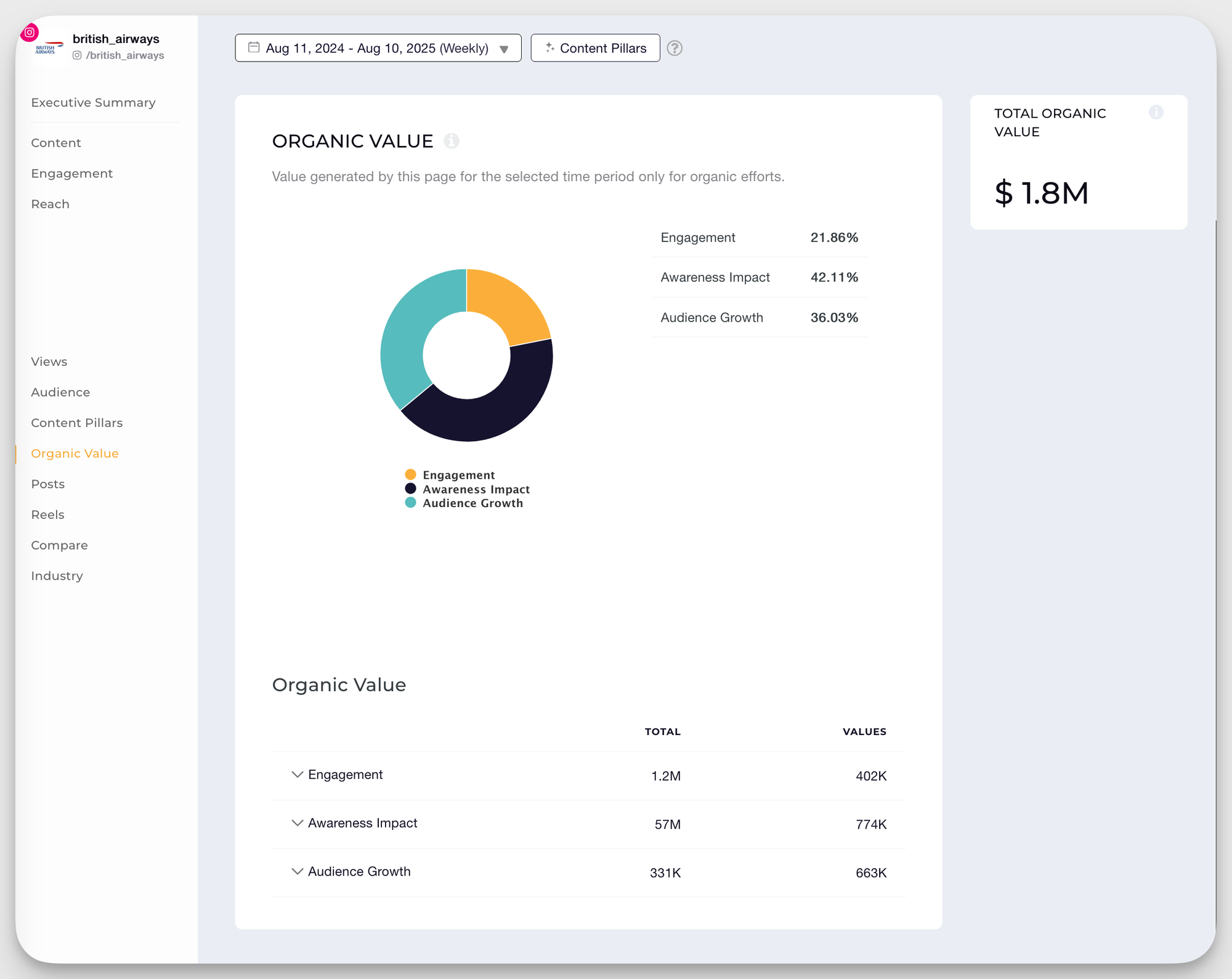
Final thoughts
To measure Instagram metrics, you have two options—you can either track your data within Instagram’s native analytics or by leveraging third-party Instagram analytics tools.
The main differences between these two options are the following: while Instagram's native KPIs feature is free, it is a bit more restrictive in terms of the data offered.
Within Instagram Insights, you can gain access to page-level metrics, including accounts reached, accounts engaged and total followers, and also to post-level data. This is useful for monitoring your metrics at a post, reels, stories, videos, or live videos level.
On the other hand, an external data solution—such as Socialinsider—offers more KPIs to help you uncover more in-depth insights about your account's performance.
Additionally, you can also track competitor's metrics and run a cross-channel performance analysis.
FAQs on Instagram metrics
What Instagram metrics social media managers should measure?
Social media managers will want to measure metrics like:
- Likes
- Comments
- Shares
- Saves
- Top posts
- Reach
- Views
- Follower growth
What Instagram metrics marketing managers should measure?
Marketing managers will want to measure metrics like:
- Reach
- Views
- Engagement
- Traffic
- Leads
What Instagram metrics CMO should measure?
CMOs will want to measure metrics like:
- Traffic
- Leads
- Conversions
Can you download Instagram metrics?
Yes! Using a third-party Instagram analytics tool like Socialinsider, you can easily export and download your reports to present with your team.
Analyze your competitors in seconds
Track & analyze your competitors and get top social media metrics and more!
You might also like
Improve your social media strategy with Socialinsider!
Use in-depth data to measure your social accounts’ performance, analyze competitors, and gain insights to improve your strategy.



